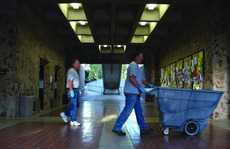SETC-United finds places to cut other than work time

Facilities workers Jack Connor, left, and Gary McDaniel, right, walk through Eureka Hall during work. :
September 24, 2009
The negotiation team of the State Employees Trades Council United toured California State University campuses during a seven-day process to conduct contract ratification and to vote on a furlough proposal.
On Sept. 1, the SETC-United announced the results of the votes where the furlough proposal was rejected by 74.5 percent and the contract ratification was passed by 90.5 percent of the voting members.
“We were real happy with a lot of changes,” said Matt Mason, union steward for Sacramento State. “It’s a tight budget and there’s really no money for anybody in the system, even with a major staffing shortage. We wanted the furloughs treated separately as a side agreement.”
Unit 6 of the SETC-United are facility workers servicing all 23 CSU campuses and the skilled trades workers servicing the UC Irvine, UCLA, UC Merced, and UC San Diego campuses. They perform trade work such as plumbing, electrical and carpentry.
“Using Unit 6 saves the state hundreds of thousands of dollars, said Patrick Hallahan, SETC chief consultant/chief negotiator. We accomplished that with this contract. It took 22 months to get the contract settled now the university must follow it.”
In June, Administrative officials of the CSU system notified SETC-United Business Manager John Connor and other SETC executive board members of their intent to impose cutbacks to Unit 6. They were given two options: 121 layoffs system-wide or accept a two-day-per-month furlough.
While the SETC-United voted not to participate in the statewide furloughs, it is taking other routes to help cut back, save the university money and contribute to closing the state’s budget deficit. Like all California state workers, SETC-United was told that even if it did take the furloughs there was no guarantee that it wouldn’t experience any layoffs.
The contract ratification consisted of major improvements and changes in the contract and created the new collective bargaining agreement for 2009 to 2011.
Article four of the contract, regarding contracting out unit work, was one of 32 articles improved in the ratifications. It states the procedural guidelines for facility service contracts.
“We’re always following behind contractors doing the work over to better suit our campus’ needs and customize the quality of the work,” Mason said.
According the contract, “The union should be notified of contracts pertaining to normal Unit 6 work. Circumstances permitting, notifications shall be prior to the start of such contracted work, and shall take the form of a letter.”
This means that the manager, assistant director or steward must be notified of the possibility of contracted work for a project and has the option to assess whether Unit 6 can do the work within the timeframe needed and whether it will be more cost-effective for Unit 6 to do the work.
SETC-United has already started to see the salary savings by doing as much work as possible in-house.
“We definitely show the need and the ability to do the work cheaper and faster than an independent contractor. By doing a job in-house we can save between $30,000 and $60,000 for one job and that is one person’s salary,” Mason said.
There are no plans for any new hires for the 53 jobs posted amongst CSU facility workers associated with SETC-United because of the hiring freeze, Mason said. There are 50 workers on the Sac State campus.
“The university has to learn, like everyone else, that it must change the way it does business, not just cut the bottom and hope the top stays afloat,” Hallahan said.
Gina Cruz can be reached at [email protected].











































































































































